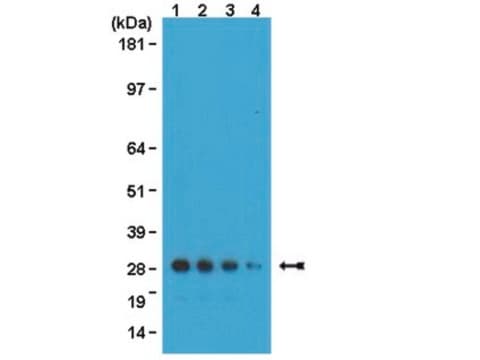11814460001
Roche
Anti-GFP
from mouse IgG1κ (clones 7.1 and 13.1)
Synonym(s):
anti-green fluorescent protein
About This Item
Recommended Products
biological source
mouse
Quality Level
conjugate
unconjugated
antibody form
purified immunoglobulin
antibody product type
primary antibodies
clone
13.1, monoclonal
7.1, monoclonal
Assay
>90% (HPLC)
form
lyophilized
packaging
pkg of 200 μg
manufacturer/tradename
Roche
isotype
IgG1κ
storage temp.
2-8°C
Related Categories
General description
Specificity
Application
- Immunoprecipitation
- Western blots
- Immunostaining
Features and Benefits
Mixture of two monoclonal antibodies, supplied as a white lyophilizatecontaining 200μg of total Anti-GFP IgG.
Anti-GFP is a mixture of two clones (7.1 and 13.1).
Quality
Purity: Both Anti-GFP mouse monoclonal antibodies (Clones 7.1 and 13.1) are >95% pure as determined by SDS-PAGE and ion-exchange HPLC analyses.
Preparation Note
The following concentrations should be taken as a guideline:
- Western blot: 1:1000 dilution
- Immunoprecipitation: 2 to 10 μg
Storage conditions (working solution): -15 to -25 °C
Reconstitution
Rehydrate on ice for 30 minutes.
Legal Information
Not finding the right product?
Try our Product Selector Tool.
Storage Class Code
13 - Non Combustible Solids
WGK
WGK 1
Flash Point(F)
does not flash
Flash Point(C)
does not flash
Certificates of Analysis (COA)
Search for Certificates of Analysis (COA) by entering the products Lot/Batch Number. Lot and Batch Numbers can be found on a product’s label following the words ‘Lot’ or ‘Batch’.
Already Own This Product?
Find documentation for the products that you have recently purchased in the Document Library.
Customers Also Viewed
Our team of scientists has experience in all areas of research including Life Science, Material Science, Chemical Synthesis, Chromatography, Analytical and many others.
Contact Technical Service














